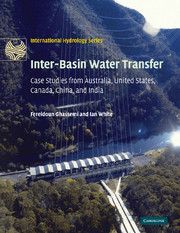Book contents
- Frontmatter
- Contents
- Foreword
- Overview and Scope
- Acknowledgements
- List of Abbreviations
- Part I The Challenges
- Part II Inter-basin Water Transfer in Australia
- 3 Land and water resources of Australia
- 4 The Snowy Mountains hydro-electric scheme
- 5 Inter-basin water transfer from coastal basins of New South Wales
- 6 The Bradfield and Reid schemes in Queensland
- 7 Three schemes for flooding Lake Eyre
- 8 The Goldfields pipeline scheme of Western Australia
- 9 Supplying Perth, Western Australia with water: the Kimberley pipeline scheme
- 10 Other schemes in Australia
- Part III Inter-basin Water Transfer in Other Selected Countries
- Part IV Appendices
- Glossary
- Index
- References
9 - Supplying Perth, Western Australia with water: the Kimberley pipeline scheme
Published online by Cambridge University Press: 05 November 2009
- Frontmatter
- Contents
- Foreword
- Overview and Scope
- Acknowledgements
- List of Abbreviations
- Part I The Challenges
- Part II Inter-basin Water Transfer in Australia
- 3 Land and water resources of Australia
- 4 The Snowy Mountains hydro-electric scheme
- 5 Inter-basin water transfer from coastal basins of New South Wales
- 6 The Bradfield and Reid schemes in Queensland
- 7 Three schemes for flooding Lake Eyre
- 8 The Goldfields pipeline scheme of Western Australia
- 9 Supplying Perth, Western Australia with water: the Kimberley pipeline scheme
- 10 Other schemes in Australia
- Part III Inter-basin Water Transfer in Other Selected Countries
- Part IV Appendices
- Glossary
- Index
- References
Summary
INTRODUCTION
Although Western Australia has significant volumes of surface and groundwater resources, the volume of water that can be economically and sustainably harvested is a fraction of the total available resources. Nearly 90 percent of the State's surface water is allocated to the environment and significant volumes of groundwater are reserved to protect groundwater dependent ecosystems (Water and Rivers Commission, 2000, p. 1). The sustainable surface water yield of the State is about 5.2 × 109 m3 yr−1, while the sustainable groundwater yield is estimated to be 6.3 × 109 m3 yr−1. These estimates are regardless of water quality and include fresh, marginal and saline waters.
Water withdrawal at the beginning of the twentieth century was very low. It increased gradually and reached 250 × 106 m3 by 1960 when the State's population was about 750 000. Total withdrawal more than doubled between 1980 and 2000 (Figure 9.1) and is expected to double again by 2020 to around 3.6 × 109 m3, reflecting the predicted increase in population to a total of more than 2.7 million. In 1999–2000, irrigated agriculture used 40 percent of the State's water withdrawal, followed by: mining 24 percent; households 13 percent; services 7 percent; gardening 5 percent; parks 4 percent; industry 4 percent; and stock water 3 percent (Government of Western Australia, 2003, pp. 7 and 8).
Water demand for irrigated agriculture is expected to increase rapidly from about 0.7 × 109 m3 in 2000 to 1.6 × 109 m3 in 2020. This is also the case for the mining industry, with a predicted increase in demand from 0.42 × 109 m3 to 0.93 × 109 m3 over the same period.
- Type
- Chapter
- Information
- Inter-Basin Water TransferCase Studies from Australia, United States, Canada, China and India, pp. 165 - 179Publisher: Cambridge University PressPrint publication year: 2007

